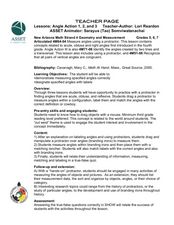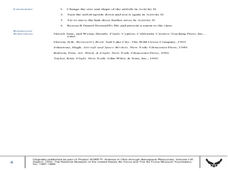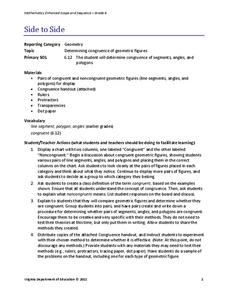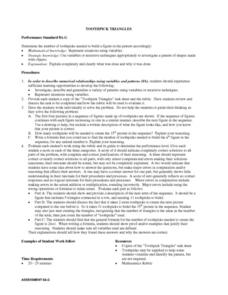Curated OER
Searching for Angles and Lines
Students work to find and reinforce concepts related to lines and angles. They identify the characteristics of shapes that have one, two, and three dimensions. The students also work on definitions related to the geometry of shapes.
Curated OER
Measuring Temperatures
Fourth graders participate in a teacher-led discussion about temperature--hot and cold. Each group of students is assigned specific materials for their lab experiment. They record temperatures measured in their journals and then plot...
Curated OER
Angles and Parallel Lines
Sixth graders draw parallel and intersecting lines to observe and examine the characteristics of alternate interior angles, vertical angles, corresponding angles, and supplementary angles. Through observation, they discover the...
Curated OER
Tomb Robbers
Sixth graders identify benchmark angles as they are embedded into a circle grid. They observe the teacher using an angle ruler and complete a Star Spangled worksheet, play the game Tomb Robbers, and as a class discuss their game winning...
Curated OER
Angle Action 1,2 and 3
Students investigate angles through construction. In this geometry lesson, students use a protractor to identify the measurement of an angle. They identify angles cut by a transversal and two parallel lines.
Curated OER
Angle-Side Relationships
Students calculate the different sides and angles of a triangle. In this geometry instructional activity, students use triangular properties to define the relationship between two triangle. They identify missing angles using the interior...
Curated OER
Basic Right Triangles
Elementary schoolers examine the attributes of triangles. In this triangle instructional activity, learners compare regular triangles and right triangles. They explore vertices and angles and investigate obtuse and acute angles. Pupils...
Curated OER
Sum of Interior/Exterior Angles with Wilbur
Students identify the interior and exterior measures of polygons. In this geometry instructional activity, students identify the formula for interior angles of polygons. They differentiate between triangular and polygons angles.
Curated OER
Grade 3 Math-Advanced 5
In this grade 3 math worksheet, 3rd graders answer a set of 20 'advanced' multiple choice questions covering a variety of concepts. Answers may be checked online.
Math Mammoth
Triangles 1
In this triangles instructional activity, learners measure and calculate the measurements of eight triangles, their sums and classify the triangles as acute, obtuse or right.
Curated OER
An Uplifting Experience
Fifth graders conduct flight experiments. In this uplifting experience lesson plan, 5th graders build an airfoil and place in a variety of conditions to observe the results of lift and force in flight, as well as angle of attack....
Curated OER
Pythagorean Theorem
Eighth graders draw right triangles and identify the parts of a right triangle: right angle, interior and exterior angles, hypotenuse and legs. They predict and identify any relationships that exist between the sides of a right...
Curated OER
Find Someone Who........
Fifth graders identify, describe, and classify lines, line segments, rays, and angles. When given a diagram of a line, they classify the line as perpendicular, parallel, intersecting, vertical, horizontal, and/or diagonal.
Curated OER
Measurement: Length, volume, and temperature
Students determine the temperature of the water in a cup, measure the length of a piece of cardboard, and measure out an appropriate volume of water. This task assesses student's abilities to perform measurement and reporting skills.
Noyce Foundation
Parallelogram
Parallelograms are pairs of triangles all the way around. Pupils measure to determine the area and perimeter of a parallelogram. They then find the area of the tirangles formed by drawing a diagonal of the parallelogram and compare their...
Inside Mathematics
Hopewell Geometry
The Hopewell people of the central Ohio Valley used right triangles in the construction of earthworks. Pupils use the Pythagorean Theorem to determine missing dimensions of right triangles used by the Hopewell people. The assessment task...
Virginia Department of Education
Side to Side
Congruent figures: two figures that want to be just like each other. Individuals learn to distinguish between figures that are congruent and those that are not. Measuring the lengths of line segments and angles helps in this endeavor.
Curated OER
Geometric Shapes and Angles
In this geometry instructional activity, 10th graders review polygons and solve for the missing angles of trapezoids and isosceles triangles. There are 10 questions on this instructional activity with an answer key.
Curated OER
Rocket Angles
Eighth graders create rockets that be launched at varying angles to determine which angle is best to launch at for the longest distance.
Curated OER
Geometry: Classifying Angles
Pupils measure, construct, and classify angles as acute, right, straight, and obtuse. Once they have completed an angle worksheet, students use a map of South Carolina to locate cities by constructing the aforementioned angles.
Houghton Mifflin Harcourt
Unit 6 Math Vocabulary Cards (Grade 4)
In need of math vocabulary cards? Use a set of 66 vocabulary cards with topics focused mostly on geometry terms. Each sheet has two cards on it. The top half has the word printed in bold text, while the bottom half has the card with...
Curated OER
Toothpick Triangles
Students draw a chart (included in the lesson) to use with their investigation. They review terminology of triangles and receive toothpicks to use in the lesson. Beginning with three toothpicks, students form a triangle. They complete...
Curated OER
Solving Problems Using Triangle Inequality Theorem
Sixth graders investigate triangles and the inequality theorem. They will collaborate in groups to determine the length of a longest side of a triangle. Then relate the size of the triangle to its angles using protractors, yard sticks,...
Curated OER
Back to the Bees (Tesselations)
Sixth graders observe the creation of a tessellation with hexagons. In groups, they work with polygons to discover what shapes can be used to create tessellations and explore the angle measurements of each shape. Using internet websites,...

























